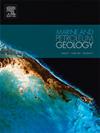Terrebonne Basin, Gulf of Mexico gas hydrate resource evaluation and 3-D modeling of basin-scale sedimentation, salt tectonics, and hydrate system evolution since the early Miocene
IF 3.7
2区 地球科学
Q1 GEOSCIENCES, MULTIDISCIPLINARY
引用次数: 0
Abstract
In assessing methane hydrate as a potential transitional energy source, quantification of in-place volumes of gas is a first step—and yet, global, regional, and even local estimates of gas volumes contained within hydrate are highly variable, including within the extensively-studied Gulf of Mexico (GoM) gas hydrate province. Here, we construct the first 3-D basin and hydrocarbon system model of the Terrebonne Basin (Walker Ridge protraction area, northern GoM) to estimate in-place resources contained as gas within hydrate, as well as to provide the first estimate of in-place resources contained within free gas accumulations in the basin. The resultant model-predicted 3-D distributions (and saturations) of hydrate are consistent with independent seismic interpretation and borehole observations. This study reveals both sedimentation-driven and salt diapir-driven gas hydrate recycling produce elevated hydrate saturations in the basin (“recycling” occurs when relative upward shifts of the gas hydrate stability zone (GHSZ) cause hydrate dissociation, generating buoyant free gas that may reaccumulate as higher-saturation hydrate at the new base of GHSZ). An important finding of this study (particularly given that, globally, the source of methane in marine hydrate systems tends to be poorly understood) is that microbial sources can explain most or all hydrate occurrences in Terrebonne Basin. We calculate that ∼32 × 109 m3 (∼1.1 × 1012 ft3) of methane gas is trapped within hydrate accumulations throughout Terrebonne Basin, while nearly 2 × 109 m3 (∼67 × 109 ft3) of methane occurs as free gas at high saturations within sandy reservoirs beneath the GHSZ and ∼35 × 109 m3 (∼1.2 × 1012 ft3) occurs as free gas at low saturations within muddy units beneath the GHSZ. In total, our calibrated 3-D model predicts that nearly 70 × 109 m3 (∼2.5 × 1012 ft3) of microbial methane is trapped as gas hydrate and free gas in the Terrebonne Basin.
求助全文
约1分钟内获得全文
求助全文
来源期刊

Marine and Petroleum Geology
地学-地球科学综合
CiteScore
8.80
自引率
14.30%
发文量
475
审稿时长
63 days
期刊介绍:
Marine and Petroleum Geology is the pre-eminent international forum for the exchange of multidisciplinary concepts, interpretations and techniques for all concerned with marine and petroleum geology in industry, government and academia. Rapid bimonthly publication allows early communications of papers or short communications to the geoscience community.
Marine and Petroleum Geology is essential reading for geologists, geophysicists and explorationists in industry, government and academia working in the following areas: marine geology; basin analysis and evaluation; organic geochemistry; reserve/resource estimation; seismic stratigraphy; thermal models of basic evolution; sedimentary geology; continental margins; geophysical interpretation; structural geology/tectonics; formation evaluation techniques; well logging.
 求助内容:
求助内容: 应助结果提醒方式:
应助结果提醒方式:


